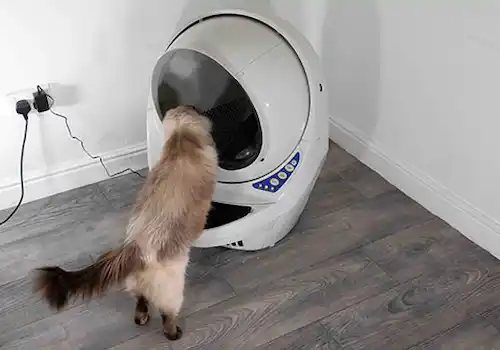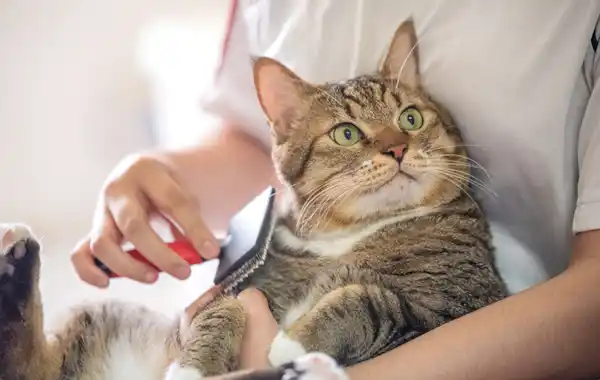We take a look at what tools owners need to maintain their cats’ fur.
Many cats struggle to groom themselves for a variety of reasons. Therefore, it is important to help your cat maintain their coat. Enlisting the support of a professional groomer can play an important role but equally, maintaining the coat between grooms is at the cornerstone of good feline health.
Hair Type and Length
Generally, long-haired cats will need more regular grooming than shorter-haired cats. Knots can form easily in longer fur and places to keep an eye on are the armpits, around the back end, and the tummy in particular. If they have a big mane, such as Norwegian Forest Cats and Maine Coons, then the chin and chest is another hot spot where knots can form very quickly. These cats also can have very fluffy, tufty ears and knots can form at the base of the ear so check there too.
Flat-faced brachycephalic cats like Persians are more prone to runny eyes and it is worth checking them daily and giving them a gentle wipe with a cotton makeup remover pad. You can get reusable ones you can wash, just put a mark on the ones designated for the cat so you don’t mix them up with any you use yourself!
Of the shorthaired cat breeds, do keep a close eye on British Shorthairs in particular. Their fur is very thick and dense so shed fur can easily get trapped if you don’t help with their grooming.

All the fluff from one groom…

…after the groom!
Older and sick cats of any fur length will need their fur checking as often they will struggle with their own grooming. They may also be in pain so unable to do those lovely yoga poses cats are so well known for, or some conditions, such as kidney and thyroid problems, can cause the cat’s coat to change and be harder to manage.
Professional cat groomer Katie Gwilt, known as The Kat Lady, shares her top home grooming tips:
1. If in doubt, always start with the widest tooth comb you have so it doesn’t pull too much. Grooming needs to be an enjoyable experience for you and your cat.
2. Don’t feel like you have to groom all of the cat in one go or every session. Pick one area to groom and then next time do a different spot. Eventually, you will work your way around the whole cat and can start again at the beginning!
3. Try to hold the comb at around a 45 degree angle and comb in the direction the fur grows. This makes sure that you get to the root of the fur and your cat gets the most benefit from the session.
4. Start with places the cat likes to be petted. Often the chin, base of the back of the neck, and shoulder area are great places to start. You can go back to these areas any time your cat is starting to get annoyed with you to relax them again.
5. Keep sessions short and build up a routine. Start with a couple of minutes and see if you can slowly increase from there. Make it a part of your quality time together and incorporate treats afterwards so your cat knows this is a lovely bonding time for you both.
6. You can always look into doing a short cat grooming course. IPet offer a 10-day OFQUAL recognised certificate which will give you the confidence to be able to groom your cat at home.
The good thing is that you don’t need any fancy equipment. There are two combs and one brush that Katie recommends:
● The Zoom Groom by Kong
A really versatile purple cat-shaped rubber brush (be sure to get the purple one as the dog-shaped ones have shorter and wider teeth) that most cats really enjoy. It is great for both short and long-haired cats and you will be amazed at the amount of loose fur it will pick up. It’s really soft and gentle and feels like you are giving your cat a good massage. The only downside is that it won’t remove any knots or mats, just dead and loose hair. It’s a great introduction brush and a lovely way to start a grooming session with your feline friend. As a special bonus for us humans, you can use the reverse to clean discarded fur from jumpers, sofas, and carpets etc.
● A Wide Toothed Comb
(also called a coarse comb)
I recommend the Rosewood coarse comb which is around £5 — £10 online. Wide toothed combs are available from most pet shops. They are really versatile and the long teeth mean you can make sure that you get to the root of the cat’s fur and don’t just brush the top (a really common mistake). You can part the fur and comb in the direction of the fur growth in small sections. The wide toothed comb will help you start to work through any knots. If you feel a pull, then try making the section even smaller to work the knot out and you can put your other hand against the cat’s fur to keep it from yanking (think about brushing a child’s hair and holding above a tangle).
Again, great for both short and long-haired cats. No matter what the length, this is a great comb for cats who have more dense fur as it’s actually the density and how thick the fur is that really matters when choosing the right comb.
From top to bottom: Zoom Groom, wide-toothed comb and moulting comb.
● A Moulting Comb
I recommend the Rosewood moulting comb which is around £5 — £10 online and in most pet stores.
This is the one that has two lengths of teeth and so will help remove more of the undercoat. If your cat has fine fur, this is a great one to really up the shine. Make sure you are combing to the root of the fur and not just the top. I don’t recommend this for tail fur, the coarse comb is much better. This one may pull out a little too much tail fur and you can over groom it, leaving it a little sparse. If you feel a pull then, as above, try a smaller section or if it is still pulling, then drop down to the wider toothed coarse comb to try to remove the knot.
● Grooming tools to avoid
My general rule of thumb is not to use something on a cat’s fur that you wouldn’t use on your own hair. Some combs and brushes have very sharp bristles which can scratch our skin. Cats have much thinner, sensitive skin so pick something that they are likely to enjoy. Likewise, combs and brushes that have very short and close together teeth/spikes aren’t ideal. They can pull and hurt which isn’t going to endear the cat to the grooming process. Some of the short, sharp teeth cut the fur rather than remove it from the root so it can look like you are having great success, but they don’t actually reach the knots or remove the fur properly. A lot of products are designed for dogs rather than cats who have different fur and skin.
Katie
About Katie Gwilt
Katie Gwilt works as The Kat Lady, a holistic master mobile cat groomer and holistic feline therapist based in Liverpool. She is the tutor for iPet’s OFQUAL cat grooming qualifications in the North West and is passionate about cat welfare. She believes it is imperative to have an understanding of cat behaviour and nutrition to be the best groomer possible. She also believes in spending time teaching proper cat handling techniques that allow the cat to be as relaxed as possible during a groom.










